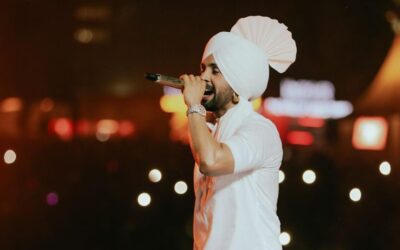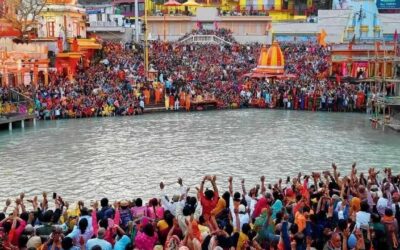Immerse into the world of surreal paintings at Mumbai’s Jehangir Art Gallery

The art journey that began in June 1990 at the auditorium hall of Jehangir Art Gallery has come full circle today. Titled, `Prabhu Joshi: The Final Exhibition`, the week-long painting spectacle begins tomorrow at Gallery 3 of the Jehangir Art Gallery. The exhibition is a retrospective showcasing the surreal imagination of the Late Prabhu Joshi.
The sublime paintings lie at the intersection of spaces devoid of human presence. Imagine silent squares, abandoned alleys, a house decaying into ruin with a ladder leaning against a wall, and mountains gradually bubbling into cold blue darkness. These paintings have developed through an internal discipline inspired by a delayed rhythm of life.
Curated by his son, Punarvasu, the only thing missing from the exhibition is the artist himself. Through this act, Punarvasu pays tribute to his father who passed away in 2021 during the second wave of the Covid-19 pandemic. In a conversation with Midday.com, he tells us that these works depict the finesse of his technical skills, handling of the medium, and compositions.
A self-taught artist, Joshi worked for All India Radio as a Transmission Executive and later joined Doordarshan. The signs of his artistic creativity began reflecting in his childhood days. When he was a kid, he was asked to paint ‘Sanjabai’, a celebratory drawing ritual conducted at the folk festival of the Malwa region, Madhya Pradesh.
At this festival, unmarried girls paint the lives of Shiva and Parvati on a wall, as a form of worship to get blessed with a groom like Shiva. Joshi would get recruited by his elder sister and her friends to draw the couple. He would happily take up the gig in exchange for raw mangoes and tamarind.
His tryst with painting began with oil colours. Later, he advanced to water colours where he perfected his art, vision, and style over a period of time. This enabled him to upskill the minimal use of the brush and align it with the natural flow of colours.
Punarvasu informs us that “Acrylics were the next set of colours he chose based on the desire to replicate what he did in water colour. Acrylics also afforded him the freedom to paint on a larger scale. Some of his landscapes are 3ft X 4ft.” Within the realm of this medium, he also painted ‘Still Life’ in an homage to old Dutch master painters in his later years.
The desire to create continued in his school days when his friends would pay him to make diagrams in their lab notebooks. Advancing to his work life, he would juggle his passion with his profession. Punarvasu recalls his father returning home in the evenings and painting his way straight into the heart of the night.
A house in ruins by Prabhu Joshi
Joshi painted in Indore and the surrounding regions of Malwa in Madhya Pradesh. His style intended to depict the colours that told their own story without the touch or direction of an artist. “His usage of the brush was minimalistic. It was the flow of water colours that painted the picture. This was his signature painting style,” reveals Punarvasu.
His inspiration to paint places devoid of human presence came from a personal phase of transition. Migrating to Indore from his ancestral village left a deep impact on his psyche and created a void that could not be filled ever. Later, he began to reproduce the void on canvas, and through short stories that he wrote in Hindi. His paintings depict a yearning, a desire to belong to a place not known.
Birds by Prabhu Joshi
His paintings also became a medium to represent environmental issues that mar the urban landscapes. In his later works with acrylic paints, he predominantly focuses on birds and how the sprawling cities are slowly devouring the natural habitats of birds. “For example, in Indore, it is difficult to spot any sparrows now. Back in the day, these birds cohabitated with humans, making their nest in our homes. Additionally, paintings of deserted streets and dilapidated buildings are an effort to draw attention to the rural-urban migration”, shares his son.
What is Punarvasu`s vision to promulgate his father`s paintings? He shares that he will continue to exhibit his paintings in different cities. More so, in metropolitan cities to highlight the trials and tribulations faced by people who are forced to leave their villages and come to metropolitan cities. His father’s writings and paintings work in tandem to highlight this message.
He also plans to have his short stories translated into the English language so that a wider audience can understand the turbulences in the lives of those who migrate. “The pain and agony which he felt when he migrated from his village to Dewas, and later to Indore was his creative fuel and again and again he harkened back to the simple village life, both in his writings and his paintings.”
Also Read: Attend the second art carnival by The Bombay Art Society in Bandra
The exhibition showcases a unique art where paintings ‘paint’ themselves with the natural flow of colours. The artist has mastered the art of using a brush minimally to let the colours narrate their own story
Search
Recent
- Karnataka BJP protests over Waqf land encroachments, slams govt’s ‘anti-poor’ policies
- Watch: Innovative or risky? Noida man converts cigarette butts into soft toys
- Virat Kohli drops a dolly in the slips, will Labuschagne punish India?
- When I hear Indian music, I automatically start moving: Vietnam dancer MT Pop
- All You Need To Know About K-Pop Boyband ONEUS Performing In New Delhi





